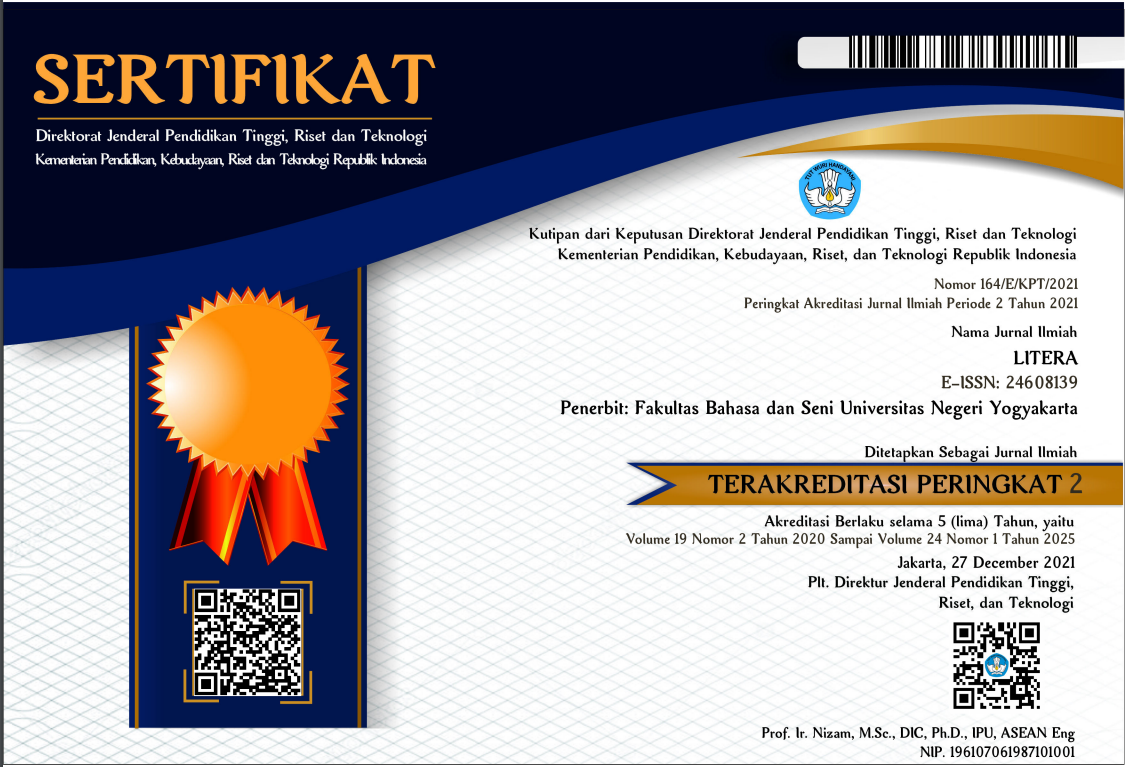Setaman flower lexicons in the Nyekar rite: Anthropolinguistics of Javanese society
Downloads
The tradition of carrying setaman flowers in the nyekar rite success to be a part of local wisdom that has survived through various periods, but on the other hand, documents about it are still limited. This study aims to describe the lexicons in kembang setaman in the nyekar rite from the Javanese perspective. Adopting qualitative method with a focus on ethnographic approach, data is collected through interview and literature study and examined using semiotic and lexical-semantic analysis. The result show seven plants that make up the setaman, including (1) roses (mawar or mawi-arsa, a sincere intention to live up to noble values), (2) jasmine (melati or melat ing ati, the sincerity of the heart), (3) white chrysolite flower (kanthil or tansah kumanthil-kanthil, uninterrupted devotion), (4) ylang (kenanga or kenangen ing angga, always remembering the ancestral heritage), (5) tuberose (sedap malam or harum dhalu, always remembering the sacred teachings of the ancestors even in the dark of the night), (6) rose balsam (pacar air or pacar banyu, prosperity continues to flow), and (7) pandan leaves (liaison with the deceased). Kembang setaman functions as a symbol of gifts accompanied by prayers sent when visiting graves which are considered homes for people who have died, and contemporary Javanese society is still carrying out this tradition. This research expands the limited field of Anthropolinguistics studies, and on the other hand, can be used as cultural documentation that encourages the intention to better conserve the local wisdom over a long period.
Downloads
Abid, M. A. B., & Saputra, D. (2021). Aktualisasi Budaya Nyekar dalam Membentuk Karakter Generasi Milenial Nahdiyah. SALIMIYA: Jurnal Studi Ilmu Keagamaan Islam, 2(3), 39-60. https://ejournal.iaifa.ac.id/index.php/salimiya
Agung, D. A. G., Nasih, A. M., & Kurniawan, B. (2024). Local wisdom as a model of interfaith communication in creating religious harmony in Indonesia. Social Sciences & Humanities Open, 9, 100827. https://www.sciencedirect.com/science/article/pii/S259029112400024X
Alfian, R. L. (2018). Dari Cultural Memory ke Cultural Identity: Tradisi Nyékar Wong Bakaran, Juwana, Pati, Jawa Tengah. Aceh Anthropological Journal, 2(2), 20-36. https://doi.org/10.29103/aaj.v2i2.1156
Aminuddin, L. O. (2019, May 4). Tradisi ziarah kubur tingkatkan pendapatan penjual daun pandan. Antara News. https://www.antaranews.com/berita/855668/tradisi-ziarah-kubur-tingkatkan-pendapatan-penjual-daun-pandan
Arrozi, P., Burhanuddin, N. F. N., & Saharudin, N. F. N. (2020). Leksikon Etnomedisin dalam Pengobatan Tradisional Sasak: Kajian Antropolinguistik. Mabasan, 14(1), 17-30. https://scholar.archive.org/work/q4qvgfm4vbfvtercou6xyxwqpi/access/wayback/https://mabasan.kemdikbud.go.id/index.php/MABASAN/article/download/308/262
Arrozi, P., Burhanuddin, N., & Saharudin, N. (2020). Leksikon Etnomedisin dalam Pengobatan Tradisional Sasak: Kajian Antropolinguistik. Mabasan, 14(1), 17–30. https://doi.org/10.26499/mab.v14i1.308
Asdar. (2018). Metode Penelitian Pendidikan: Suatu Pendekatan Praktik. Yogyakarta: Pustaka AQ.
Balai Penelitian Tanaman Hias. (2015). Budidaya Sedap Malam. Leaflet. Direktorat Jenderal Hortikultura.
Basir, U. P. M. (2017). Fenomena Bahasa Nama dalam Budaya Jawa: Kajian Aspek Filosofis dan Fakta Sosial. Lokabasa, 8(1), 112-126. https://ejournal.upi.edu/index.php/lokabasa/article/view/15972/8929
Buana, P. P., Rustiyanti, S., & Suryamah, D. (2023). Struktur Dalam dan Tritangtu: Kawin Cai di Babakan Mulya, Kuningan, Jawa Barat. Jurnal Budaya Etnika, 7(2), 135-148. http://dx.doi.org/10.26742/jbe.v7i2.1572
Dastenbaevna, A. N. (2022). Phytophoric Names in Karakalpak Anthroponymy. Indiana Journal of Arts & Literature, 3(4), 1-3. https://zienjournals.com/index.php/tjpch/article/view/1305
Erniwati. (2017). Semantik Leksikal Pantun dalam Sastra Bima. Undergraduate Thesis. Universitas Muhammadiyah Makassar. https://digilibadmin.unismuh.ac.id/upload/655-Full_Text.pdf
Farningrum, A. (2023). Kantil Sebagai Sumber Ide Penciptaan Motif Batik pada Busana Casual Wanita. Doctoral dissertation. Institut Seni Indonesia Surakarta.
Firdaus, E. N., Kriswanto, M., Padang, N. B., Saputra, K. J., Arifin, N. H., Fatmawati, G., & Ardhian, D. (2022). Leksikon Tanaman pada Boneka Petra dalam Ritual Kematian Masyarakat Tengger Sebagai Simbol Leluhur: Kajian Antropolinguistik. SEBASA: Jurnal Pendidikan Bahasa dan Sastra Indonesia, 5(2), 279-289. https://doi.org/10.29408/sbs.v5i2.5901
Fitri, A. (2018). Bunga Cempaka Putih dalam Penciptaan Keramik Dekoratif Fungsional. Undergraduate Thesis thesis. Institut Seni Indonesia Yogyakarta. http://digilib.isi.ac.id/4020/
Geertz, C. (2014). Agama Jawa: Abangan, Santri, Priyayi dalam Kebudayaan Jawa (terj. Aswab Mahasin dan Bur Rasuanto). Jakarta: Komunitas Bambu.
Herawati, N. F. N. (2016). Akronim dalam Bahasa Jawa. LOA: Jurnal Ketatabahasaan dan Kesusastraan, 11(1), 11-20. https://doi.org/10.26499/loa.v11i1.1653
Heryamien, D. A. (2016). Kembang Setaman sebagai Ide Dasar Penciptaan Batik Tulis Busana Pesta. Pend. Seni Kerajinan-S1 (e-Craft), 5(4), 1-13. https://journal.student.uny.ac.id/ojs/index.php/ecraft/article/view/4902
Hidayah, N. (2016) Karakteristik Pigmen Antosianin dari Esktrak Dua Jenis Bunga Melalui Kopigmentasi Tanin Ekstrak Daun Jambubiji (Psidiumguajava). Other thesis. University of Muhammadiyah Malang. https://eprints.umm.ac.id/35851/
Hidayat, S., & Napitupulu, R. M. (2015). Kitab Tumbuhan Obat. Jakarta: Agriflo. https://repositori.uma.ac.id/bitstream/123456789/1778/6/138700010_file5.pdf
Hidayati, N., Sukerta, P. M., Supriyanto, E., & Pamardi, S. (2023). Sundel: Reinterpretasi Bunga Sedap Malam dalam Motif Bordir dan Sulam. Jurnal Narada, 10(1), 67-81. http://10.2241/narada.2023.v10.i1.006
Hieronymus. (2013). Tumpas Penyakit dengan 40 Daun dan 10 Akar Rimpang. Yogyakarta: Cahaya jiwa.
Higginbottom, G. M. A., Pillay, J. J., & Boadu, N. Y. (2013). Guidance on performing focused ethnographies with an emphasis on healthcare research. The Qualitative Report, 18(17), 1–6. https://doi.org/10.46743/2160-3715/2013.1550
Hooker, C. J., & Tyndall, D. E. (2023). Application of case study research and ethnography methods: Lessons learned. Applied Nursing Research, 73, 151713. https://www.sciencedirect.com/science/article/pii/S0897189723000472
Integrated Taxonomic Information System (ITIS). (2023). Integrated Taxonomic Information System Report. https://www.itis.gov/
Irmawati, W. (2013). Makna Simbolik Upacara Siraman Pengantin Adat Jawa. Walisongo: Jurnal Penelitian Sosial Keagamaan, 21(2), 309–330. https://doi.org/10.21580/WS.21.2.247
Kamino, S. S. (2015). Deskripsi Sedap Malam Varietas Wonotirto. Direktorat Perbenihan Hortikultura Kementrian Pertanian RI.
Keane, W. (2003). Semiotics and the social analysis of material things. Language & Communication, 23(3–4), 409–425. https://doi.org/10.1016/S0271-5309(03)00010-7
Layungkuning, B. (2013). Sangkan Paraning Dumadi Orang Jawa dan Rahasia Kematian. Yogyakarta: Penerbit Narasi.
Luardini, A. M., Natalina, A., & Garner, M. (2019). Ecolinguistics of ethno-medicinal plants of the Dayak Ngaju community. Language Sciences, 74, 77-84. https://doi.org/10.1016/j.langsci.2019.04.003
Lyons, J. (1977). Semiotics Semantics Volume 1. Cambridge: Cambridge University Press.
Majalah Suara Pendidikan. (2020, February 5). Bunga pacar air membuat rejeki terus mengalir. Majalah Suara Pendidikan | Good News Information. https://www.majalahsuarapendidikan.com/2020/02/bunga-pacar-air-membuat-rejeki-terus.html#google_vignette
Marlina, N., & Rohayati, E. (2009). Teknik Perbanyakan Mawar dengan Kultur Jaringan. Buletin Teknik Pertanian, 14(2): 65-67. https://lib.ui.ac.id/detail?id=129968&lokasi=lokal
Maulana, C. (2015). Ritual "Nyekar", Cultural Capital,dan Mobilitas Politik di Indramayu. In Right: Jurnal Agama Dan Hak Azazi Manusia, 4(2). https://ejournal.uin-suka.ac.id/syariah/inright/article/viewFile/1285/1113
Mekarisce, A. A. (2020). Teknik Pemeriksaan Keabsahan Data pada Penelitian Kualitatif di Bidang Kesehatan Masyarakat. Jurnal Ilmiah Kesehatan Masyarakat, 12(3), 145-151. https://doi.org/10.52022/jikm.v12i3.102
Mumfangati, T. (2007). Tradisi Ziarah Makam Leluhur Pada Masyarakat Jawa. Jurnal Jantra, 2(3), 152-159. https://kebudayaan.kemdikbud.go.id/bpnbyogyakarta/wp-content/uploads/sites/24/2014/06/Jantra_Vol._II_No._3_Juni_2007.pdf#page=32
Mustakim, A. O. P., Yunitasari, I., Laasiliyah, M.L., Sari, R.N., & Kamalia, A.Z. (2022). Kajian Etnobotani Tradisi Temu Manten pada Pernikahan Adat Masyarakat Jawa di Daerah Dungus Madiun. Pisces: Proceeding of Integrative Science Education Seminar, 2. https://prosiding.iainponorogo.ac.id/index.php/pisces/article/view/684
Nurlaili, S. (2009). Dimensi Metafisik Tradisi Grebeg Maulud Keraton Kasunanan Surakarta. Kudus: Maseifa Jendela Ilmu.
Pajarianto, H., Pribadi, I., & Sari, P. (2022). Tolerance between Religions through the Role of Local Wisdom and Religious Moderation. HTS Teologiese Studies/Theological Studies, 78(4), 7043. https://doi.org/10.4102/hts.v78i4.7043
Paraskevaidis, P., & Weidenfeld, A. (2021). Perceived and projected authenticity of visitor attractions as signs: A Peircean semiotic analysis. Journal of Destination Marketing & Management, 19, 100515. https://doi.org/10.1016/j.jdmm.2020.100515
Pramulia, P. (2019). Sinkretisme dalam Serat Centhini Jilid I Karya Sri Susuhanan Pakubuwana V. Jurnal Ilmiah FONEMA: Jurnal Edukasi Bahasa dan Sastra Indonesia, 2(2), 144-159. https://doi.org/10.25139/fn.v2i2.1812
Prasetyo, M. A. (2021). Leksikon Tanaman Obat dalam Kitab Primbon Betaljemur Adammakna (Kajian Ekolinguistik). JALIE: Journal of Applied Linguistics and Islamic Education, 5(2), 242-273. https://doi.org/10.33754/jalie.v5i2.315
Rosidin, O., Riansi, E. S., & Muhyidin, A. (2021). Leksikon Kuliner Tradisional Masyarakat Kabupaten Pandeglang. Litera, 20(1), 49-75. https://journal.uny.ac.id/index.php/litera/article/view/33908/pdf
Rudiyanto, R., Rais, W. A., & Purnanto, D. (2020). Etnolinguistics Study: Cultural Meaning of Sranan Tradition as a Form Local Wisdom of Mountain Farmer Society in Kebumen. In Prosiding Seminar Nasional Linguistik dan Sastra (SEMANTIKS), 2(-), 543-552. https://jurnal.uns.ac.id/prosidingsemantiks/article/view/45047
Santoso, W. J. (2017). Analisis Sosio-Ekono-Ekolinguistik terhadap Pemertahanan Leksikon Tanaman Tradisonal untuk Bumbu Masak bagi Mahasiswi di Kota Semarang. JP-BSI (Jurnal Pendidikan Bahasa dan Sastra Indonesia), 2(2), 69-76. https://dx.doi.org/10.26737/jp-bsi.v2i2.250
Saussure, F. D. (1966). Course in general linguistics. New York, NY: McGraw-Hill.
Setyani, I. (2020, May 31). Ketupat Daun Pandan dan Filosofi Singkat Tentangnya. Jurnaba. https://jurnaba.co/ketupat-daun-pandan-dan-filosofi-singkat-tentangnya/
Sibarani, T. (2016). Kosakata Tanaman Tradisional Obat-obatan dalam Bahasa Batak Toba Kajian Antropolinguistik. Medan Makna, 14(2), 169–179. https://core.ac.uk/download/pdf/229285637.pdf
Silalahi, M., & Wahyuningtyas, R. S. (2020). Penuntun Praktikum Sistematika Tumbuhan. Jakarta: UKI Press.
Toha, M. (2016). Kontestasi Pandangan Elite Agama di Gresik tentang Nyekar di Desa Surowiti Kecamatan Panceng. Teosofi: Jurnal Tasawuf dan Pemikiran Islam, 6(1), 193–219. https://doi.org/10.15642/teosofi.2016.6.1.193-219
Wahyuni, S., Bakry, M. M., & Ilyas, M. (2022). Tradisi Ziarah Kubur Setelah Hari Pernikahan dalam Perspektif Hukum Islam. Qadauna: Jurnal Ilmiah Mahasiswa Hukum Keluarga Islam, 3(2), 409-421. https://journal3.uin-alauddin.ac.id/index.php/qadauna/article/view/25255
Wijayakusuma. (2000). Tumbuhan Berkhasiat Obat Indonesia (Jilid I). Jakarta: Penerbit Pustaka Kartini.
Wulandari, A. R. (2021). Tradisi Nyekar di Magetan Perspektif Islam. Inovatif: Jurnal Penelitian Pendidikan Agama dan Kebudayaan, 7(1), 64-145. https://jurnal.iaih.ac.id/index.php/inovatif/article/view/190
Wulandari, N. D., Nugraha, N., & Kaswati, A. (2023). Makna Filosofis Uborampe Pasang Tarub dan Siraman pada Upacara Pernikahan Adat Jawa di Kradenan Jawa Tengah. Mukadimah: Jurnal Pendidikan, Sejarah, dan Ilmu-ilmu Sosial, 7(2), 265-276. https://doi.org/10.30743/mkd.v7i2.7038
Yuliatin, Y., Haslan, M. M., Sawaludin, S., & Basariah, B. (2021). Kurikulum PPKn dan Peluang Pengembangan Pendidikan Karakter Berbasis Kearifan Lokal. Prosiding SAINTEK, 3, 471-482. https://jurnal.lppm.unram.ac.id/index.php/prosidingsaintek/article/view/249
Yuna, A P. (2008) Respon Pertumbuhan Bibit Kenanga (Cananga odorata (Lamk) Hook.f. & Thomson forma macrophylla) pada Berbagai Intensitas Cahaya, Penggunaan Inang Primer Kriminil dan Jenis Media. Undergraduate Thesis. Institut Pertanian Bogor. http://repository.ipb.ac.id/handle/123456789/11148
Yuniarti, D. (2010). Pengaruh Perajangan Bunga Kenanga (Cananga Odorata Baill), Kepadatan dan Metode Penyulingan terhadap Rendemen dan Mutu Minyak Kenanga yang Dihasilkan. Undergraduate Thesis. Fakultas Teknologi Pertanian Institut Pertanian Bogor, Bogor. http://repository.ipb.ac.id/handle/123456789/62191
Zakiyah, M., Setiawati, E., & Rohman, A. S. (2021). Makna Puji Saji dalam Sesaji Sura di Selametan Sumber Banyu atau Ritual Tirta Amerta di Pura Sumberawan Toyomarto Singosari Malang. In ISCS 2020: Proceedings of the 1st International Seminar on Cultural Sciences (ISCS), p.138. EAI: European Alliance for Inovation. http://dx.doi.org/10.4108/eai.4-11-2020.2308907
Zed, M. (2018). Metode Penelitian Kepustakaan (cetakan kelima). Jakarta: Yayasan Obor.
Zulfa, I., & Suyatno. (2022). Pemakaian Leksikon dalam Tradisi Penjamasan Pusaka Sunan Kalijaga di Kabupaten Demak (Sebuah Kajian Antropolinguistik). Nusa: Jurnal Ilmu Bahasa dan Sastra, 17(3), 236-245. https://doi.org/10.14710/nusa.17.3.236-245
Zulyan, Z., & Hasibuan, M. (2022). Analisis Makna Upacara Tolak Balak di Desa Talang Tengah II Kecamatan Pematang Tiga Kabupaten Bengkulu Tengah. Equilibrium: Jurnal Pendidikan, 10(2), 241-247. https://journal.unismuh.ac.id/index.php/equilibrium/article/view/7493
























